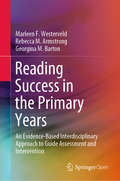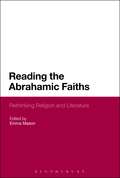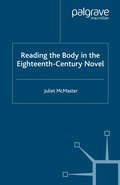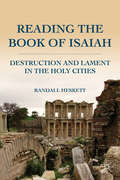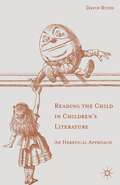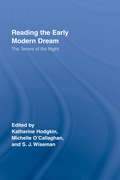- Table View
- List View
Reading Success in the Early Primary Years: A Teacher's Guide to Implementing Systematic Instruction
by Jocelyn SeamerReading Success in the Early Primary Years is a step-by-step guide to structured literacy instruction for teachers working in the early years of primary school. Written by a teacher, for teachers, this book supports teachers to understand the evidence base of reading instruction and how to successfully implement it. Structured in three parts, the book breaks down complex concepts in a concise, accessible manner, guiding teachers on eight key actions to take to get every child on the path to reading proficiency. These include instruction in phonics, phonological and phonemic awareness, integrated reading and spelling opportunities, and the use of decodable texts. Highly practical, Reading Success in the Early Primary Years offers over 20 explicit instructional routines that teachers can implement in their classrooms and guidance on how to get the most out of instructional time. These practical elements are further supported by a summary of relevant research and theories about how reading develops, including an outline of high impact, explicit teaching that draws on cognitive load theory. Rich with sample lesson plans, tools, and examples from real classrooms, this book allows teachers to get on with the business of teaching reading. This is a must-have resource for all who are responsible for children’s reading instruction in the first three years of school.
Reading Success in the Primary Years: An Evidence-Based Interdisciplinary Approach to Guide Assessment and Intervention (Springerbriefs In Education Ser.)
by Marleen F. Westerveld Rebecca M. Armstrong Georgina M. BartonThis open access book describes the Reading Success project, in which a 5-step, assessment-to- intervention process, based on the Simple View of Reading, was used within a primary school setting in Australia to better support those students who struggle with reading. It provides an easily accessible overview of each step of the process involved in implementing this approach and highlights the crucial importance of collaboration between professionals involved in the teaching of reading within a school setting. It focuses on the decision-making processes used, such as rich dialogue with the leadership team and teachers, and shares participants’ perspectives gathered throughout the project. Using case studies, the book describes how the 5-step approach assists in creating detailed profiles of students’ strengths and weaknesses in spoken and written language skills that can be used to guide targeted intervention This book offers valuable insights for educators, speech pathologists, researchers, and pre-service teacher education students interested in the teaching of reading
Reading T.S. Eliot: Four Quartets and the Journey towards Understanding
by G. AtkinsThis book offers an exciting new approach to T.S. Eliot's Four Quartets as it shows why it should be read both closely and in relation to Eliot's other works, notably the poems The Waste Land, 'The Hollow Men,' and Ash-Wednesday.
The Reading Teacher's Book of Lists (J-B Ed: Book of Lists)
by Edward B. Fry Jacqueline E. KressThe essential handbook for reading teachers, now aligned with the Common Core The Reading Teacher's Book of Lists is the definitive instructional resource for anyone who teaches reading or works in a K-12 English language arts-related field. Newly revised and ready for instant application, this top seller provides up-to-date reading, writing, and language content in more than 240 lists for developing targeted instruction, plus section briefs linking content to research-based teaching practices. This new sixth edition includes a guide that maps the lists to specific Common Core standards for easy lesson planning, and features fifty brand-new lists on: academic and domain-specific vocabulary, foundation skills, rhyming words, second language development, context clues, and more. This edition also includes an expanded writing section that covers registers, signal and transition words, and writers' craft. Brimming with practical examples, key words, teaching ideas, and activities that can be used as-is or adapted to students' needs, these lists are ready to differentiate instruction for an individual student, small-group, or planning multilevel instruction for your whole class. Reading is the center of all school curricula due to recent state and federal initiatives including rigorous standards and new assessments. This book allows to you skip years of curating content and dive right into the classroom armed with smart, relevant, and effective plans. Develop focused learning materials quickly and easily Create unit-specific Common Core aligned lesson plans Link classroom practice to key research in reading, language arts and learning Adapt ready-made ideas to any classroom or level It's more important than ever for students to have access to quality literacy instruction. Timely, up to date, and distinctively smart, The Reading Teacher's Book of Lists should be on every English language arts teacher's desk, librarian's shelf, literacy coach's resource list, and reading professor's radar.
The Reading Teacher's Book of Lists (J-B Ed: Book of Lists)
by Jacqueline E. Kress Edward B. FryThe essential handbook for reading teachers, now aligned with the Common Core The Reading Teacher's Book of Lists is the definitive instructional resource for anyone who teaches reading or works in a K-12 English language arts-related field. Newly revised and ready for instant application, this top seller provides up-to-date reading, writing, and language content in more than 240 lists for developing targeted instruction, plus section briefs linking content to research-based teaching practices. This new sixth edition includes a guide that maps the lists to specific Common Core standards for easy lesson planning, and features fifty brand-new lists on: academic and domain-specific vocabulary, foundation skills, rhyming words, second language development, context clues, and more. This edition also includes an expanded writing section that covers registers, signal and transition words, and writers' craft. Brimming with practical examples, key words, teaching ideas, and activities that can be used as-is or adapted to students' needs, these lists are ready to differentiate instruction for an individual student, small-group, or planning multilevel instruction for your whole class. Reading is the center of all school curricula due to recent state and federal initiatives including rigorous standards and new assessments. This book allows to you skip years of curating content and dive right into the classroom armed with smart, relevant, and effective plans. Develop focused learning materials quickly and easily Create unit-specific Common Core aligned lesson plans Link classroom practice to key research in reading, language arts and learning Adapt ready-made ideas to any classroom or level It's more important than ever for students to have access to quality literacy instruction. Timely, up to date, and distinctively smart, The Reading Teacher's Book of Lists should be on every English language arts teacher's desk, librarian's shelf, literacy coach's resource list, and reading professor's radar.
Reading Test - Year 3 (PDF)
by Catherine CaseyCheck your child's progress with these new format National Curriculum SATs tests. These practice tests are designed to check children's level of understanding at the end of Year 3. Each pack comes with three complete practice tests (test papers and corresponding reading booklets), and an accompanying Guidance and Mark Scheme booklet. These practice tests have a similar look and feel to the new Key Stage 2 reading SATs test, to help familiarise children with both the content and format of these tests. The tests can be used to track progress in school, but can also be used in the home. The guidance and mark scheme provides advice for parents and carers on how to use the tests and how to support children in preparing for them. Scholastic National Curriculum Revision: Year 3 is also available, offering children the opportunity to check their progress across the English curriculum and to develop the skills they need for these national tests.
Reading the Abrahamic Faiths: Rethinking Religion and Literature
by Emma MasonRethinking religion and literature in a series of chapters by leading international scholars, Reading the Abrahamic Faiths opens up a dialogue between Jewish, Christian, Islamic and Post-Secular literary cultures.Literary studies has absorbed religion as another interdisciplinary mode of inquiry without always attending to its multifacted potential to question ideologically neutral readings of culture, belief, emotion, politics and inequality. In response, Reading the Abrahamic Faiths contributes to a reevaluation of the nexus between religion and literature that is socially, affectively and materially determined in its sensitivity to the expression of belief.Each section – Judaism, Christianity, Islam and Post-Secularism – is introduced by a specialist in these respective areas to introduce the critical readings of the texts and discourses that follow.
Reading the Abrahamic Faiths: Rethinking Religion and Literature
by Emma MasonRethinking religion and literature in a series of chapters by leading international scholars, Reading the Abrahamic Faiths opens up a dialogue between Jewish, Christian, Islamic and Post-Secular literary cultures.Literary studies has absorbed religion as another interdisciplinary mode of inquiry without always attending to its multifacted potential to question ideologically neutral readings of culture, belief, emotion, politics and inequality. In response, Reading the Abrahamic Faiths contributes to a reevaluation of the nexus between religion and literature that is socially, affectively and materially determined in its sensitivity to the expression of belief.Each section – Judaism, Christianity, Islam and Post-Secularism – is introduced by a specialist in these respective areas to introduce the critical readings of the texts and discourses that follow.
Reading the American Novel 1780 - 1865 (Reading the Novel)
by Shirley SamuelsReading the American Novel 1780-1865 provides valuable insights into the evolution and diversity of fictional genres produced in the United States from the late 18th century until the Civil War, and helps introductory students to interpret and understand the fiction from this popular period. Offers an overview of early fictional genres and introduces ways to interpret them today Features in depth examinations of specific novels Explores the social and historical contexts of the time to help the readers’ understanding of the stories Explores questions of identity - about the novel, its 19th-century readers, and the emerging structure of the United States - as an important backdrop to understanding American fiction Profiles the major authors, including Louisa May Alcott, Charles Brockden Brown, James Fenimore Cooper, Nathaniel Hawthorne, Herman Melville, Harriet Beecher Stowe, alongside less familiar writers such as Fanny Fern, Caroline Kirkland, George Lippard, Catharine Sedgwick, and E. D. E. N. Southworth Selected by Choice as a 2013 Outstanding Academic Title
Reading the American Novel 1780 - 1865 (Reading the Novel)
by Shirley SamuelsReading the American Novel 1780-1865 provides valuable insights into the evolution and diversity of fictional genres produced in the United States from the late 18th century until the Civil War, and helps introductory students to interpret and understand the fiction from this popular period. Offers an overview of early fictional genres and introduces ways to interpret them today Features in depth examinations of specific novels Explores the social and historical contexts of the time to help the readers’ understanding of the stories Explores questions of identity - about the novel, its 19th-century readers, and the emerging structure of the United States - as an important backdrop to understanding American fiction Profiles the major authors, including Louisa May Alcott, Charles Brockden Brown, James Fenimore Cooper, Nathaniel Hawthorne, Herman Melville, Harriet Beecher Stowe, alongside less familiar writers such as Fanny Fern, Caroline Kirkland, George Lippard, Catharine Sedgwick, and E. D. E. N. Southworth Selected by Choice as a 2013 Outstanding Academic Title
Reading the American Novel 1865 - 1914 (Reading the Novel #6)
by G. R. ThompsonAn indispensable tool for teachers and students of American literature, Reading the American Novel 1865-1914 provides a comprehensive introduction to the American novel in the post-civil war period. Locates American novels and stories within a specific historical and literary context Offers fresh analyses of key selected literary works Addresses a wide audience of academics and non-academics in clear, accessible prose Demonstrates the changing mentality of 19th-century America entering the 20th century Explores the relationship between the intellectual and artistic output of the time and the turbulent socio-political context
Reading the American Novel 1865 - 1914 (Reading the Novel #5)
by G. R. ThompsonAn indispensable tool for teachers and students of American literature, Reading the American Novel 1865-1914 provides a comprehensive introduction to the American novel in the post-civil war period. Locates American novels and stories within a specific historical and literary context Offers fresh analyses of key selected literary works Addresses a wide audience of academics and non-academics in clear, accessible prose Demonstrates the changing mentality of 19th-century America entering the 20th century Explores the relationship between the intellectual and artistic output of the time and the turbulent socio-political context
Reading the American Novel 1920-2010 (Reading the Novel)
by James PhelanThis astute guide to the literary achievements of American novelists in the twentieth century places their work in its historical context and offers detailed analyses of landmark novels based on a clearly laid out set of tools for analyzing narrative form. Includes a valuable overview of twentieth- and early twenty-first century American literary history Provides analyses of numerous core texts including The Great Gatsby, Invisible Man, The Sound and the Fury, The Crying of Lot 49 and Freedom Relates these individual novels to the broader artistic movements of modernism and postmodernism Explains and applies key principles of rhetorical reading Includes numerous cross-novel comparisons and contrasts
Reading the American Novel 1920-2010 (Reading the Novel)
by James PhelanThis astute guide to the literary achievements of American novelists in the twentieth century places their work in its historical context and offers detailed analyses of landmark novels based on a clearly laid out set of tools for analyzing narrative form. Includes a valuable overview of twentieth- and early twenty-first century American literary history Provides analyses of numerous core texts including The Great Gatsby, Invisible Man, The Sound and the Fury, The Crying of Lot 49 and Freedom Relates these individual novels to the broader artistic movements of modernism and postmodernism Explains and applies key principles of rhetorical reading Includes numerous cross-novel comparisons and contrasts
Reading the Animal in the Literature of the British Raj
by S. RajamannarDiscusses the production and circulation of animal narratives in colonial India in order to investigate the constructs of animals played into a variety of forms of othering that took place in England during its imperial venture.
Reading the Body in the Eighteenth-Century Novel
by J. McMasterMcMaster's lively study looks at the various codes by which Eighteenth-century novelists made the minds of their characters legible through their bodies. She tellingly explores the discourses of medicine, physiognomy, gesture and facial expression, completely familiar to contemporary readers but not to us, in ways that enrich our reading of such classics as Clarissa and Tristram Shandy , as well as of novels by Fanny Burney, Mary Wollstonecraft and Jane Austen.
Reading the Book of Isaiah: Destruction and Lament in the Holy Cities
by R. HeskettRandall Heskett uses both historical criticism and a form-critical approach to analyze and assess Lamentation and Restoration of Destroyed Cities as oral traditions of ancient Israelite prophetic genres.
Reading the Brontë Body: Disease, Desire and the Constraints of Culture
by Beth TorgersonAnne, Emily, and Charlotte Brontë's literary representations of illness and disease reflect the major role illness played in the lives of the Victorians and its frequent reoccurrence within the Brontës' personal lives. An in-depth analysis of the history of nineteenth-century medicine provides the necessary cultural context to understand these representations, giving modern readers a sense of how health, illness, and the body were understood in Victorian England. Together, medical anthropology and the history of medicine offer a useful lens with which to understand Victorian texts. Reading the Brontë Body is the first scholarly attempt to provide both the theoretical framework and historical background to make such a literary analysis of the Brontë novels possible, while exploring how these representations of disease and illness work within a larger cultural framework.
Reading the Child in Children's Literature: An Heretical Approach
by D. RuddAn essential text that provides students with a dynamic, sophisticated and controversial look at the critical representation of the child in children's literature, arguing for a more open and eclectic approach: one that celebrates the diverse power, appeal and possibilities of children's literature. Drawing on psychoanalytically informed perspectives, David Rudd shows students how theory can be both exciting and liberating. This is a thought-provoking supplementary text for modules on Children’s Literature or Literary Theory which may be offered at the upper levels of an undergraduate Literature degree. In addition it is a stimulating resource for advanced students who may be studying children’s literature or literary theory as part of a taught postgraduate degree in Literature.
Reading the Contemporary Irish Novel 1987 - 2007 (Reading the Novel)
by Liam HarteReading the Contemporary Irish Novel 1987–2007 is the authoritative guide to some of the most inventive and challenging fiction to emerge from Ireland in the last 25 years. Meticulously researched, it presents detailed interpretations of novels by some of Ireland’s most eminent writers. This is the first text-focused critical survey of the Irish novel from 1987 to 2007, providing detailed readings of 11 seminal Irish novels A timely and much needed text in a largely uncharted critical field Provides detailed interpretations of individual novels by some of the country’s most critically celebrated writers, including Sebastian Barry, Roddy Doyle, Anne Enright, Patrick McCabe, John McGahern, Edna O’Brien and Colm Tóibín Investigates the ways in which Irish novels have sought to deal with and reflect a changing Ireland The fruit of many years reading, teaching and research on the subject by a leading and highly respected academic in the field
Reading the Contemporary Irish Novel 1987 - 2007 (Reading the Novel)
by Liam HarteReading the Contemporary Irish Novel 1987–2007 is the authoritative guide to some of the most inventive and challenging fiction to emerge from Ireland in the last 25 years. Meticulously researched, it presents detailed interpretations of novels by some of Ireland’s most eminent writers. This is the first text-focused critical survey of the Irish novel from 1987 to 2007, providing detailed readings of 11 seminal Irish novels A timely and much needed text in a largely uncharted critical field Provides detailed interpretations of individual novels by some of the country’s most critically celebrated writers, including Sebastian Barry, Roddy Doyle, Anne Enright, Patrick McCabe, John McGahern, Edna O’Brien and Colm Tóibín Investigates the ways in which Irish novels have sought to deal with and reflect a changing Ireland The fruit of many years reading, teaching and research on the subject by a leading and highly respected academic in the field
Reading the Early Modern Dream: The Terrors of the Night
by Katharine HodgkinDreams have been significant in many different cultures, carrying messages about this world and others, posing problems about knowledge, truth, and what it means to be human. This thought-provoking collection of essays explores dreams and visions in early modern Europe, canvassing the place of the dream and dream-theory in texts and in social movements. In topics ranging from the dreams of animals to the visions of Elizabeth I, and from prophetic dreams to ghosts in political writing, this book asks what meanings early modern people found in dreams.
Reading the Early Modern Dream: The Terrors of the Night
by Sue Wiseman Katharine Hodgkin Michelle O'CallaghanDreams have been significant in many different cultures, carrying messages about this world and others, posing problems about knowledge, truth, and what it means to be human. This thought-provoking collection of essays explores dreams and visions in early modern Europe, canvassing the place of the dream and dream-theory in texts and in social movements. In topics ranging from the dreams of animals to the visions of Elizabeth I, and from prophetic dreams to ghosts in political writing, this book asks what meanings early modern people found in dreams.
Reading the Early Modern English Diary
by Miriam NandiReading the Early Modern Diary traces the historical genealogy, formal characteristics, and shifting cultural uses of the early modern English diary. It explores the possibilities and limitations the genre held for the self-expression of a writer at a time which considerably pre-dated the Romantic cult of the individual self. The book analyzes the connections between genre and self-articulation: How could the diary come to be associated with emotional self-expression given the tedium and repetitiveness of its early seventeenth-century ancestors? How did what were once mere lists of daily events evolve into narrative representations of inner emotions? What did it mean to write on a daily basis, when the proper use of time was a heavily contested issue? Reading the Early Modern Diary addresses these questions and develops new theoretical frameworks for discussing interiority and affect in early modern autobiographical texts.
Reading the East India Company 1720-1840: Colonial Currencies of Gender (Women in Culture and Society)
by Betty JosephIn Reading the East India Company, Betty Joseph offers an innovative account of how archives—and the practice of archiving—shaped colonial ideologies in Britain and British-controlled India during the eighteenth and nineteenth centuries. Drawing on the British East India Company's records as well as novels, memoirs, portraiture and guidebooks, Joseph shows how the company's economic and archival practices intersected to produce colonial "fictions" or "truth-effects" that strictly governed class and gender roles—in effect creating a "grammar of power" that kept the far-flung empire intact. And while women were often excluded from this archive, Joseph finds that we can still hear their voices at certain key historical junctures. Attending to these voices, Joseph illustrates how the writing of history belongs not only to the colonial project set forth by British men, but also to the agendas and mechanisms of agency—of colonized Indian, as well as European women. In the process, she makes a valuable and lasting contribution to gender studies, postcolonial theory, and the history of South Asia.

